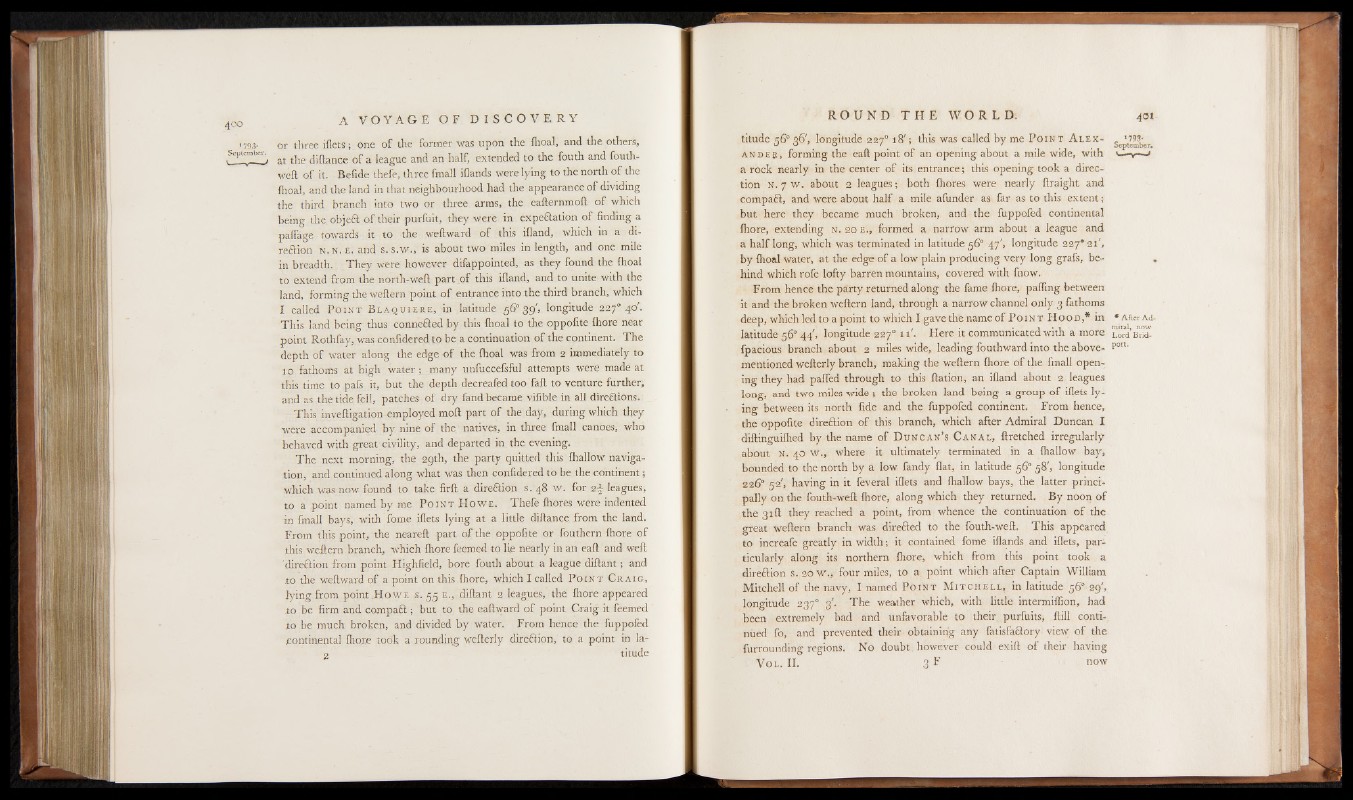
1793. or three iflets; one of the former was upon the fhoal, and the others,
September., ^ tJie diftance o f a ieagUe and an half, extended to the fouth and fouth-
weft of it. Befide thefe, three fmall iflands were lying to the north of the
fhoal, and the land in that neighbourhood had the appearance of dividing
the third branch into two or three arms, the eafternmoft o f which
being the, objeCl of their purfuit, they were in expectation of finding a
paffage towards it to the weft ward of this ifland, which in a direction
n . n . e : and s .s .w ., is about two miles in length, and one mile
in breadth. They were however difappointed, as they found the fhoal
to extend from the north-weft part of this ifland, and to unite with the
land, forming the weftern point o f entrance into the third branch, which
I called Point Blaquiere, in latitude 56° 39', longitude 2270 40'.
This land being thus connected by this fhoal to the oppofite fhore near
point Rothfay, was confidered to be a continuation of the continent. The
depth of water along the edge of the fhoal was from 2 immediately to
10 fathoms at high water; many unfuccefsful attempts were made at
this time to pafs it, but the depth decreafed too faft to venture further;
and as the tide fell, patches of dry fand became vifible in all directions.
This inveftigation employed moft part of the day, during which they
were accompanied by nine of the natives, in three fmall canoes, who
behaved with great civility, and departed in the evening.
The next morning, the 29th, the party quitted this fhallow navigation,
and continued along what was then confidered to be the continent;
which was now found to take firft a direction s. 48 w , for 2\ leagues,
to a point named by me Point H owe. Thefe fhores were indented
in fmall bays, with fome iflets lying at a little diftance from the land.
From this point, the neareft part of the oppofite or fouthern fhore of
this weftern branch, which fhore feemed to lie nearly in an eaft and weft
direction from point Highfield, bore fouth about a league diftant; and
to the weftwardof apoint on this fhore, whichlcalled Point C raig,
lying from point .Howe s . 55 e., diftant 2 leagues, the fhore appeared
.to be firm and compaCl; but to the eaftward of point Craig it feemed
to be much broken, and divided by water. From hence the fuppofed
continental fhone took a rounding wefterly direction, to a point in la2
titude
titude 56° 36', longitude 227018'; this was called by me P o i n t A lex-
A n d e s , forming the eaft point of an opening about a mile wide, with <—■v —*
a rock nearly in the center o f its entrance; this opening took a direction
n. 7 w . about 2 leagues ■ both fhores were nearly ftraight and
compaCl, and were about half a mile afunder as far as to this extent;
but here they became much broken, and the fuppofed continental
fhore, extending n. 20 e., formed a narrow arm about a league and
a half long, which was terminated in latitude 56° 47', longitude 227* 21',
by fhoal water, at the edge of a low plain producing very long grafs, behind
which rofe lofty barren mountains, covered with fnow.
From hence the party returned along the fame fhore, pafling between
it and the broken weftern land, through a narrow channel only 3 fathoms
deep, which led to a point to which I gave the name of Point Hood,* in ‘ After a,i.
latitude 56° 44', longitude 227° 11'. Here it communicated with a more i^ B n a
fpacious branch about 2 miles wide, leading fouthward into the above- port'
mentioned wefterly branch, making the weftern fhore o f the fmall opening
they had palled through to this ftation, an ifland about 2 leagues
long, and two miles wide ; the broken land being a group of iflets lying
between its north fide and the fuppofed continent. From hence,
the oppofite direction of this branch, which after Admiral Duncan I
diftinguifhed by the name of D uncan’s C anal, ftretched irregularly
about n. 40 w., where it ultimately terminated in a fhallow bay,
bounded to the north by a low fandy flat, in latitude 56° 58', longitude
226° 52', having in it feveral iflets and fhallow bays, the latter principally
on the fouth-weft fhore, along which they returned. By noon of
the 31ft they reached a point, from whence the continuation o f the
great weftern branch was directed to the fouth-weft. This appeared
to increafe greatly in width; it contained fome iflands and iflets, particularly
along its northern fhore, which from this point took a
direction s. 20 w ., four miles, to a point which after Captain William
Mitchell of the navy, I named Point Mitchel l , in latitude 56° 29',
longitude 237° 3'. The weather which, with little intermiflion, had
been extremely bad and unfavorable to their purfuits, ftill conti-.
niied fo, and prevented their obtaining any fatisfaClory view of the
furrounding regions. No doubt however could exift o f their haying
V ol. II. 3 F now